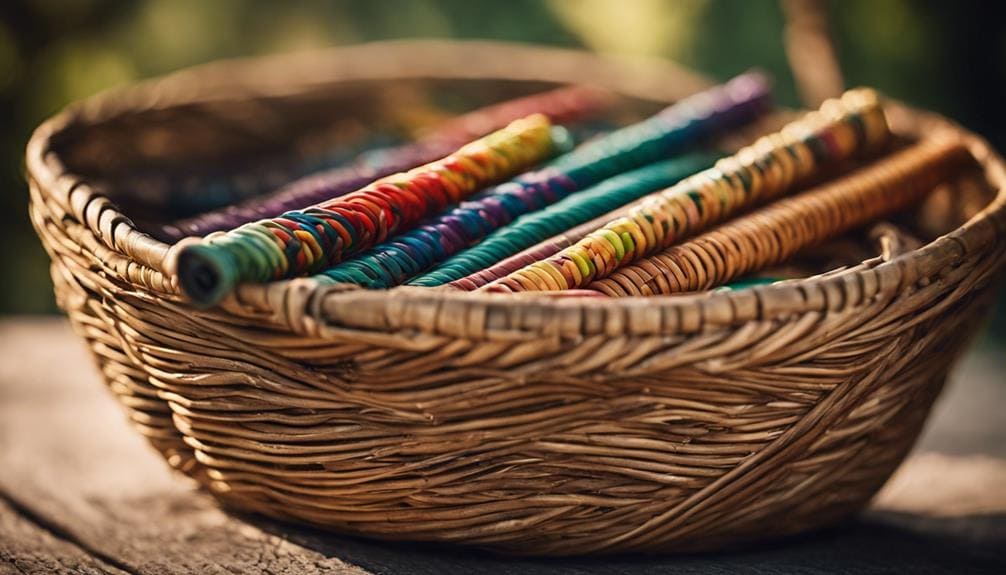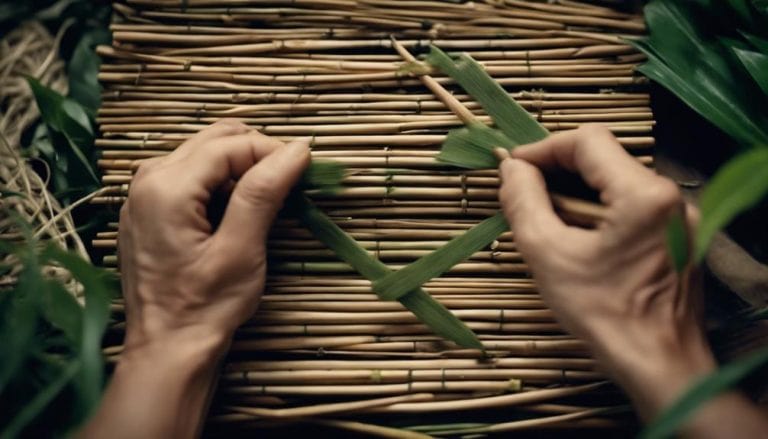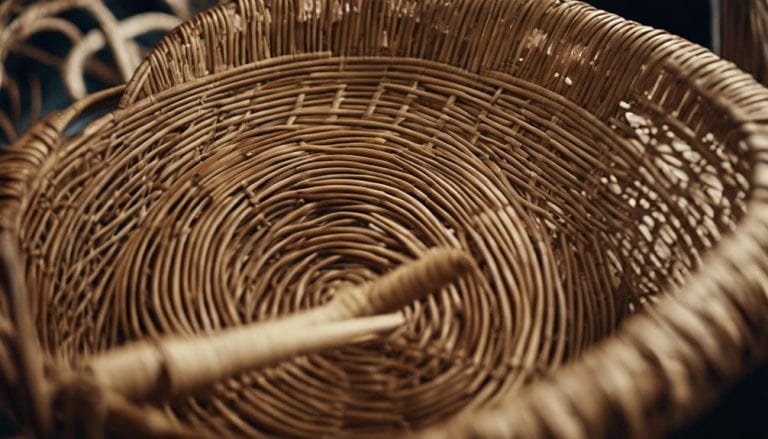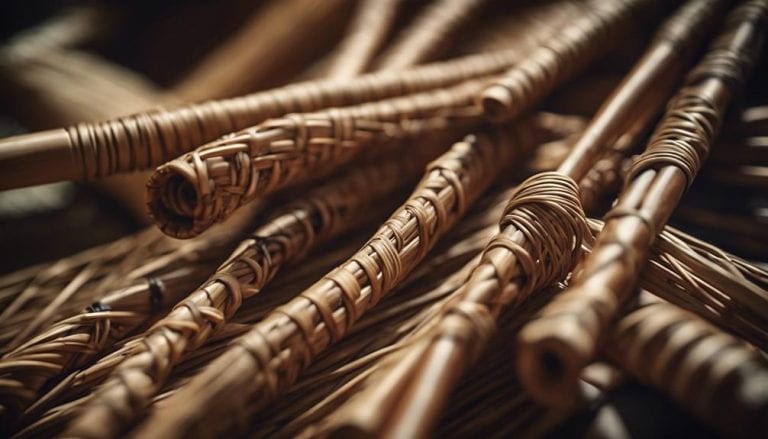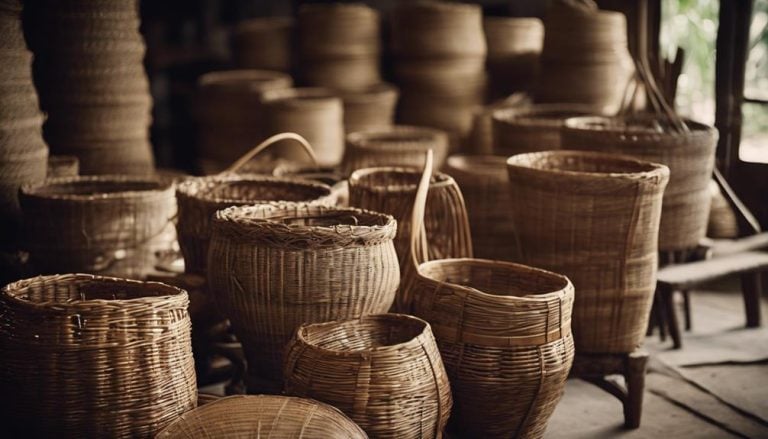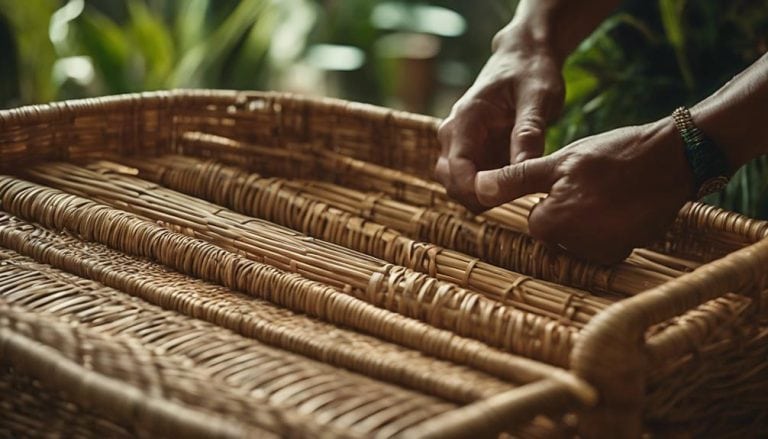Types of Rattan Cane for Weaving Baskets
Just as a painter selects from a palette of colors to bring a canvas to life, I navigate the diverse world of rattan cane when embarking on a new basket weaving project. From the slender finesse of hand cane, suitable for intricate patterns, to the robustness of round cane, each type offers a unique texture and strength, shaping the character of the final piece.
The choice between hand cane, lapping cane, center cane, and others greatly influences the weaving process and the aesthetic outcome. I’m eager to explore how each variety can transform an ordinary basket into a masterpiece, sparking a conversation on the artistic possibilities within these natural fibers.
Several types of rattan cane are used for weaving baskets, each with unique qualities. Understanding these variations can help you choose the type for your weaving projects.
Key Takeaways
- Rattan cane varieties range from 1.5mm to 10mm, accommodating intricate and robust basket weaving.
- Eco-friendly and sustainable, rattan is preferred for creative and durable basketry.
- Synthetic and natural rattan types, including cane, reed, and Manau, offer versatility for indoor and outdoor use.
- Hand cane sizes from 1.60mm to 4.00mm are ideal for crafting detailed, high-quality baskets.
Understanding Rattan Cane
Delving into the world of rattan cane, I’ve come to appreciate its remarkable blend of flexibility and strength, a true testament to nature’s ingenuity in weaving materials. The essence of rattan cane properties lies in its origin—the climbing palm Calamus species. It’s fascinating how this natural material, with diameters ranging from a slender 1.5mm to a robust 10mm, offers such versatility. This variance in size not only caters to a multitude of weaving options but also to the creation of intricate designs that appeal deeply to the artistic soul in me.
Rattan cane applications are as diverse as they are enchanting. From weaving baskets that carry the scent of tradition to crafting furniture that speaks the language of contemporary elegance, rattan cane seamlessly bridges the gap between the past and the present. Its sustainability, derived from the outer skin of the rattan palm, speaks to a growing consciousness towards eco-friendly practices. In my hands, it becomes more than just a material; it’s a medium through which I express creativity, employing different weaving patterns and techniques to bring unique basket designs to life.
Common Rattan Varieties

Exploring the realm of rattan for basket weaving, I’ve discovered that varieties such as cane, reed, synthetic, and manau rattan each bring unique qualities to the craft. These materials offer a spectrum of textures and strengths and reflect a deep understanding of rattan cane characteristics and weaving techniques.
Here’s a closer look at each:
- Cane Rattan: Known for its exceptional flexibility and durability, it allows me to create baskets that can withstand daily use while maintaining their beauty. Its sustainability is a testament to the environmental impact conscious choices can have in the crafting world.
- Reed Rattan: Its smooth, uniform texture opens a gateway to weaving intricate designs that captivate and mesmerize. Reed Rattan’s consistency is key for projects requiring fine detail and precision.
- Synthetic Rattan: A modern marvel, synthetic rattan offers the resilience and uniformity I need for outdoor or moisture-prone environments, ensuring longevity and ease of maintenance.
- Manau Rattan: When strength and a natural aesthetic are paramount, manau rattan stands out. It’s ideal for creating sturdy, long-lasting woven baskets that carry the essence of the earth within their fibers.
Each variety speaks to the heart of sustainability and the minimal environmental impact we strive for in our weaving practices.
Fine Rattan Selections
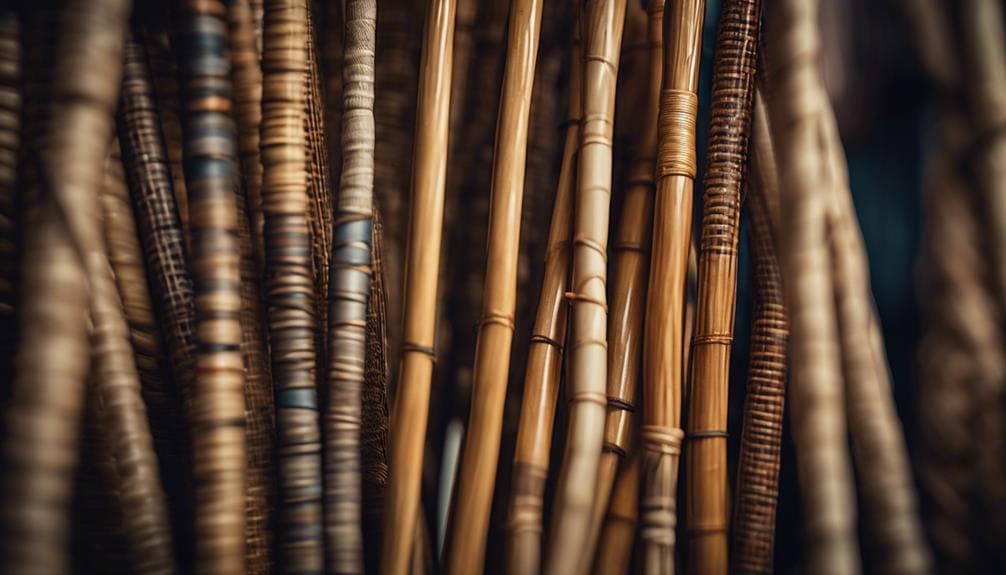
After examining the common rattan varieties, let’s focus on the nuanced world of fine rattan selections, where basket weaving reaches new heights of intricacy and elegance. Within this realm, hand cane emerges as a quintessential material, its sizes ranging from the delicate 1.60mm to a more robust 4.00mm. This variety isn’t merely about dimensions; it’s about the potential to create intricate patterns and delicate weaves that transform a simple basket into a work of art.
Delving deeper, I’ve found hand cane’s delicate and detailed weave particularly suited for crafting small or decorative baskets. These creations aren’t just containers; they’re narratives woven into form, each thread contributing to the overall design’s complexity and beauty. The versatility in textures and designs achievable with the range of hand cane sizes allows me, as an artisan, to explore detailed designs and versatile textures, each piece a testament to the material’s smooth, uniform finish.
This fine selection of rattan, thus, isn’t just about the material; it’s a doorway to expressing creativity, where skilled craftsmen and artisans like myself venture to craft high-quality, finely woven baskets. Each creation showcases intricate designs, turning the act of basket weaving into a celebration of elegance and artistry.
Sturdy Rattan Types

Turning our attention to the robust world of sturdy rattan types, we find that materials like hand cane, center cane, flat splint, and reed stand at the forefront of crafting durable baskets designed to endure. These options provide the backbone for creations that last and cater to the intricate weaving techniques required for basket durability. In selecting the right cane, one must consider both the aesthetic and the structural integrity it brings.
- Hand Cane: Available in sizes from 1.60mm to 4.00mm, it’s my go-to for weaving sturdy baskets that don’t compromise elegance.
- Centre Cane: Flat Splint and Reed are my allies in creating durable basket structures. Each adds a unique texture and strength.
- Round Cane: With sizes ranging from 1.5mm to 10mm, it offers a blend of strength and flexibility, crucial for baskets that see daily use.
- Pre-woven Cane Panelling: For those moments when time is of the essence, it provides a robust design element that’s both practical and beautiful.
In my journey through the rattan world, these materials have proven indispensable. Their strength, paired with the right weaving techniques, ensures the creation of baskets that stand the test of time.
Flexible Rattan for Weaving

Diving into the world of flexible rattan for basket weaving, I’ve discovered that materials like rattan core 3mm B hank and wheat straw braid offer unparalleled pliability and strength for crafting intricate designs. Sourced from the lush tropical regions of Indonesia and Vietnam, these rattan materials allow for the creation of artistic designs and emphasize the importance of sustainable basketry.
Utilizing the rattan core, priced attractively at 9.22€ Incl.VAT, I’ve been able to explore various rattan weaving techniques, each adding a unique texture and pattern to my baskets—the slightly more expensive, yet equally flexible, wheat straw braid at 23.43€ Incl.VAT for 100m has introduced a different dimension to my work, allowing for broader artistic expressions.
With their environmental impact in mind, these materials have become my go-to for weaving. The durability and flexibility of the rattan core and wheat straw braid ensure that each basket I weave holds artistic value and stands as a testament to the sustainable practices in basketry. Through my work, I aim to highlight the beauty and eco-friendliness of using flexible rattan.
Rare and Exotic Rattans
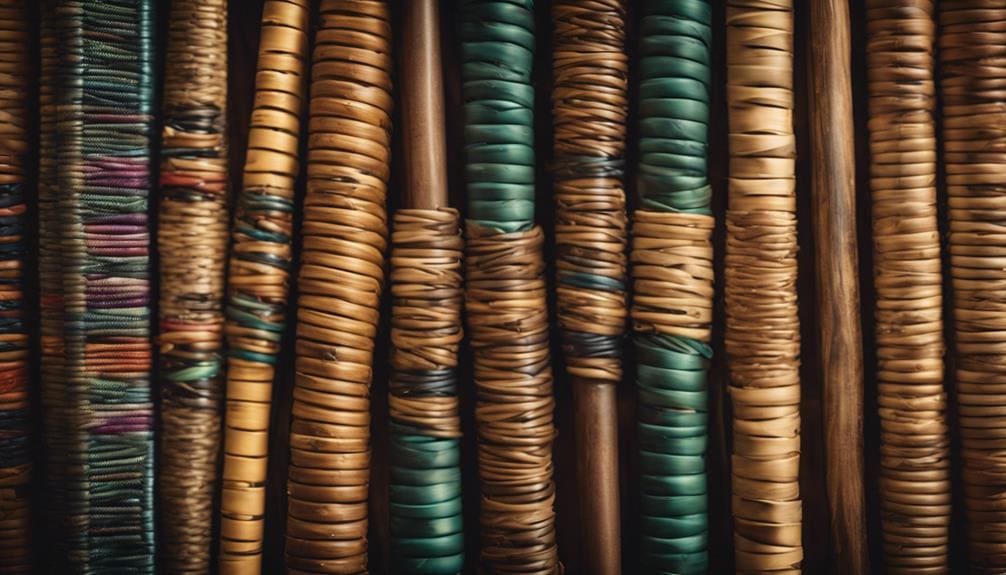
Exploring beyond the realm of flexible rattan, I’ve encountered the allure of rare and exotic rattans, each with its unique charm and complexities, ideal for weaving baskets that truly stand apart. While challenging to procure due to their limited availability, these materials offer a canvas for intricate patterns that captivate the connoisseur’s heart.
Here are four mesmerizing types I’ve worked with:
- Rare Black Rattan from Indonesia: Its deep, enigmatic color provides a striking contrast, creating baskets that are not just containers but art pieces.
- Golden Rattan from the Philippines: This variety adds a touch of luxury, making each basket a treasure trove of golden hues.
- Tiger Rattan: This rattan’s striped appearance is spectacular, weaving patterns that mimic the majestic beast.
- Rainbow Rattan: For those who thrive on color, this rattan offers a spectrum of vibrant hues, bringing joy and brightness to any design.
Working with these rare and exotic rattans is a journey of discovery. Each project becomes a testament to the beauty and rarity of these materials, creating baskets that are not just functional but truly extraordinary.
Caring for Rattan Baskets
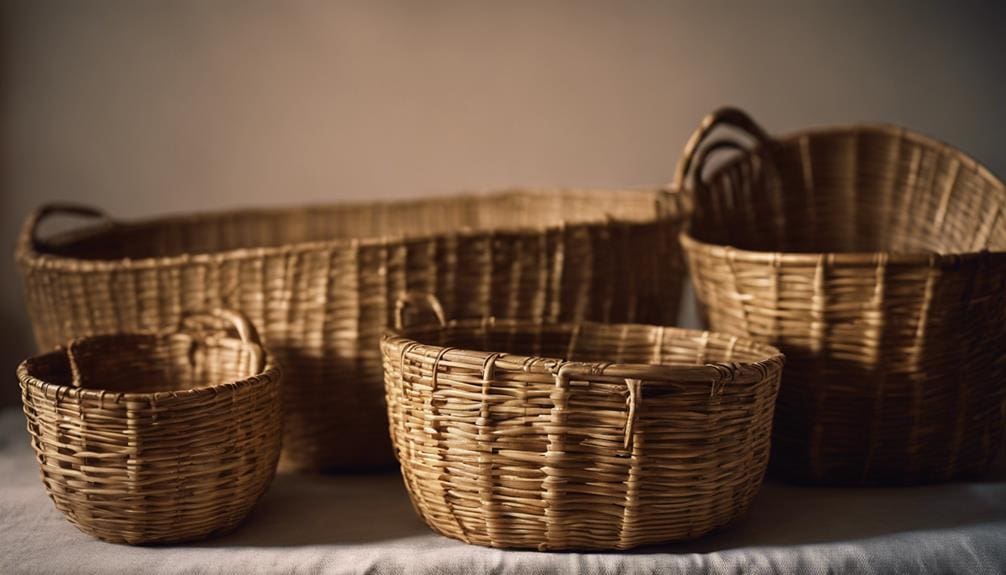
To ensure the lasting beauty of your woven treasures, it’s crucial to master the art of caring for rattan baskets. My journey with these delicate pieces has taught me the importance of rattan maintenance and cleaning tips that keep them looking their best. It’s a simple yet profound practice.
My first commandment is to avoid direct sunlight and excessive moisture. This prevents the heartbreak of fading colors and the dread of mold. I’ve found that regular dusting with a soft cloth or brush is akin to caressing the basket’s soul, maintaining its appearance and cleanliness.
When I encounter spills or stains, I act swiftly, wiping them with a damp cloth and mild soap before drying them thoroughly. This is a gentle reminder that harsh chemicals and abrasive materials are foes, not friends, of rattan’s natural fibers.
Rattan storage and preservation techniques are my secret to longevity. Storing baskets in a dry, well-ventilated area wards off warping and mold, ensuring they stand the test of time. This intimate dance of care and preservation allows me to weave a narrative of beauty and durability into every piece.
Frequently Asked Questions
What Are the Different Types of Rattan Weave?
I’ve explored various rattan weaves, embracing their durability and intricate weaving techniques. Each type offers a unique texture, from hand cane’s delicate patterns to robust round cane, enriching my artistic endeavors with intimacy and detail.
What Is the Difference Between Rattan and Cane?
I’ve learned that rattan offers sustainability with its durable nature, which is ideal for sturdy creations. In contrast, the cane’s flexibility allows for intricate, tender designs. Both materials weave together not just baskets but stories of craftsmanship.
What Are the Best Sticks for Basket Weaving?
As the saying goes, “The right tool for the right job,” I’ve found that the best sticks for basket weaving perfectly balance harvesting techniques with moisture content. They’re not just sticks; they’re the soul of my craft.
What Is the Best Material for Wicker Baskets?
In my years of crafting, I’ve found rattan cane to be the best material for wicker baskets. Its durability considerations and moisture resistance ensure long-lasting, beautiful pieces that resonate with my artistic soul.
Conclusion
In my journey through the art of basket weaving, I’ve encountered many rattan types, each with its unique charm. An interesting statistic that fascinates me is that approximately 70% of the world’s rattan is harvested from Indonesia, a testament to the material’s deep-rooted cultural and economic significance. This diversity in rattan enriches our craft and connects us to distant lands and traditions. Caring for these baskets means preserving a piece of the world’s natural and cultural heritage.

